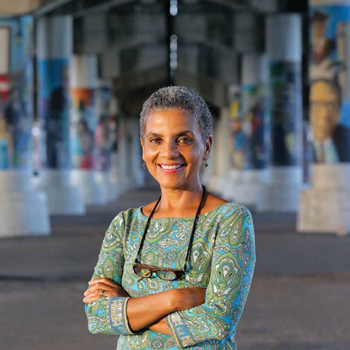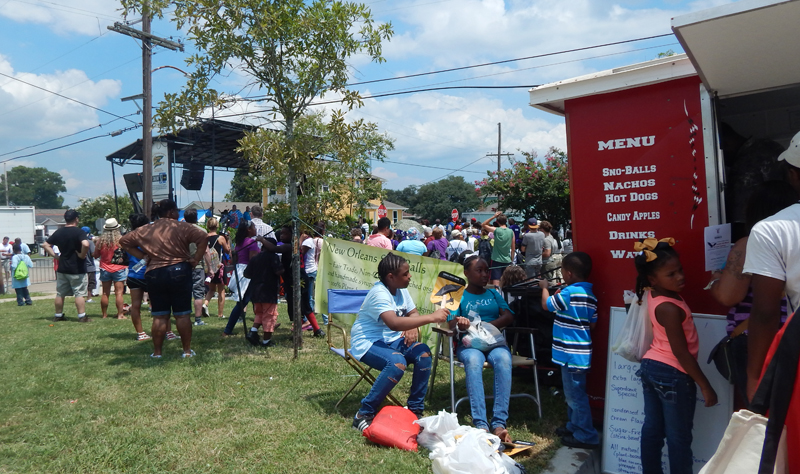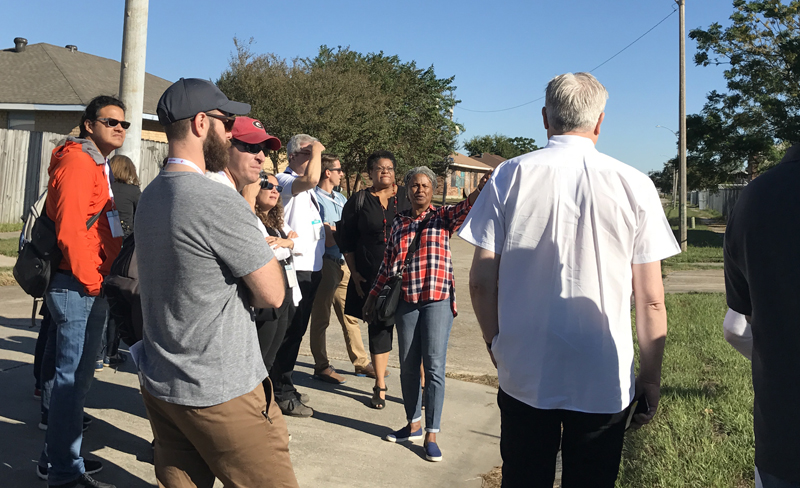News
Interview with Diane Jones Allen
 Diane Jones Allen, ASLA / Landscape Architecture Magazine (LAM)
Diane Jones Allen, ASLA / Landscape Architecture Magazine (LAM)
Here in New Orleans, you have been involved in the Lower Ninth Ward, one of the neighborhoods hardest hit by Hurricane Katrina. Ten years after the storm, what has changed? Has anything improved?
Ten years after the storm, the community has totally changed. The Lower Ninth Ward had about 18,000 residents before Katrina. Today, it has roughly 6,000, so two-thirds of the population is gone. There were over 1,000 vacant lots before the storm; now, there's about 7,000.
There are little pockets of improvement where houses have been built, but a lot of housing still needs to be built. Improvement means there was a plan that things were going to get better.
In New Orleans, 100,000 African Americans have not returned. They're in Houston, Atlanta, Baltimore or Los Angeles. When you lose that amount of a population, it affects the overall culture, economy -- everything.
So the Lower Nine is a different Lower Nine. 6,000 remain. Some were here pre-Katrina, but there's an influx of new people. There is a lot of vacant land that needs to become housing.
Over the past decade, has planning and design improved the lives of low-income communities in New Orleans? If so, how?
When Katrina happened, one of the responses afterwards was to shut down or restructure public housing. It's never good to be poor or live in subsidized housing, but it was a lot easier before, because the public housing was located adjacent to Canal Street, so people were close to where they worked and other families. Someone said the underground drug culture even changed, because the city spread these people all around, whereas before they were in one place.
When you close down that much public housing, there's a lot of people that don't have housing. Some of the housing, like Lafitte and Magnolia Housing, still have low-income residents, but there were a lot of restrictions in terms of felony records that kept people from coming back. Public housing in the most desirable neighborhoods became market rate and mixed income.
So a large portion of the people in public housing -- poor people -- were shifted to New Orleans East, which is across the Industrial Canal and has little public transit infrastructure. New Orleans East is a transit desert. (This is discussed in my forthcoming book, Lost in the Transit Desert: Race, Transit Access, and Urban Form). New Orleans East is not currently a job center. They just rebuilt the hospital there 11 years later. And a lot of the affluent African American community that was in New Orleans East left. So now you have a population that's under-served and underprivileged or shifted away from resources.
For some people, New Orleans is much better. If you live in one of the nicer neighborhoods or are a young person that came from afar, there are all these tech and movie jobs. There are many new stores and restaurants.
In my opinion, Katrina was a boom for some people and a bust for many others.
FEMA's new flood map for New Orleans marks 50 percent of the city as "safe," meaning homeowners and commercial property owners in these zones don't need to buy flood insurance. According to NPR, "Intermap analyzed thousands of coastal properties and found virtually no difference between FEMA's high and low risk zones, two neighborhoods might have different insurance rates but essentially the same risk of actual physical flooding." What does this say to you about the flood insurance system in New Orleans?
Damage from flooding in New Orleans is not all based on geography like in other places. It's not all based on whether you're in the flood zone. For instance, the Lower Ninth Ward is not the lowest area in the city, but the flood walls were not structurally sound. We also have to look at dredging. They dredged the Mississippi Gulf Outlet, which allowed salt water intrusion, so there was no protection from the storm surge. So there are a lot of man-made factors that influence what happened.
Flood insurance isn't affordable. Post-Katrina a lot of people who can't afford it have been shifted to places that are low and at risk. They've been shifted to New Orleans East and St. Bernard Parish. They're living in lower areas and have to pay a higher flood rate.
It's really complicated because much of the situation is man-made.
Last year the city released its first ever comprehensive resilience strategy, in part financed by the Rockefeller Foundation, which emphasized environmental adaptation, equity and governance. In your experience, what differentiates a resilient community from one that is not?
Many times when these plans are done, the most affected don't participate.
The French Quarter and Garden District, which actually happen to be on the higher land, are economically valuable. People come to the city to be there. But New Orleans East is valuable, because the people who actually shape much of the culture, and make the art and music, serve the drinks, and shuck the oysters, live there.
Resiliency plans only work to me if they're going to be resilient and sustained, if they're going to create community stewards and stakeholders. I'm using all that design outreach language, but, you know. The most effective plans are co-generated with the community, because
they are the ones who are going to be impacted by what happens.
People realize we're living with water. But the question is: how do we protect the landscape, but also protect the rights of everyone?
 Community event in Lower Ninth Ward, New Orleans / Diane Jones Allen
Community event in Lower Ninth Ward, New Orleans / Diane Jones Allen
Earlier this year, Louisiana received $95 million from the Rebuild by Design competition to adapt to climate change. Some of those funds will also help the tribal Houma community on Isle de Jean Charles whose land is submerged by an amazing 98 percent since 1955 move to a new location. Given New Orleans is experiencing both sea level rise and sinking land, can you imagine this city conducting a strategic retreat in places, or have to move communities wholesale to new locations?
Right after Katrina, there was the "green dot plan," which basically asked, "Why should people be allowed to come back, for instance, to the Lower Nine? Why should people be able to come back into a place that would flood?"
We are experiencing sea level rise and coastal erosion. A lot of that erosion is man-made because of dredging and shipping channels.
For me, the solution is rethinking density and diversity and helping people realize they're going to have to live closer together with different people. We also have to densify so you can move people together safely, but keep them in the same region.
When Katrina occurred, a lot of people moved to Baton Rouge, because they thought that was safe. Now we just had flooding in Baton Rouge. We want to stay in our state and region. We should -- it's rich in heritage and culture and unique.
But we're going to have to rethink how we live on the land. We're going to have to be more sustainable in terms of how we use our resources and infrastructure. Right now, we all want to spread out and live in our own space. Sea level rise, flooding, coastal erosion are fighting against that way of living.
On a panel at the Landscape Architecture Foundation (LAF) summit on the new landscape declaration, you discussed the concerns you have with landscape architecture students and professors helicoptering into low-income communities to help with a project for a semester, often not to be seen again. What can landscape architecture programs do to more deeply engage and connect in these places where they want to help?
Professors need to do a lot of preparation before the semester starts. They need to take time to bring the community into the preparation, understand the situation, create a partnership with the community, and then come up with an action plan of what you're leaving. A design studio is really about the students learning. They only have a semester, so what value are these 20 or so students really going offer for these communities?
Yesterday at the ASLA Annual Meeting, we hosted a field session called Beyond the Edge. We visited three communities dealing with critical life and death situations. One is living on a landfill, the other one's living next to the port, and the other one is dealing with a prison population. My trepidation was whether it was even a good thing to bring the field trip there.
My trepidation was: will I be bringing these people in to gawk? After a lot of discussion with members of the community, they wanted people to come. So we were able to meet with them, and they actually invited us into their homes. We went to a community college and talked with community members. We came up with a follow-through so we could reach out to them after this session.
 ASLA 2016 Annual Meeting Tour "Beyond the Edge" at Gordon Plaza / Diane Jones Allen
ASLA 2016 Annual Meeting Tour "Beyond the Edge" at Gordon Plaza / Diane Jones Allen
In a nutshell, that's what should happen if you're going to do engagement. You have to really work with the community beforehand. The field session generated so many ideas, a lot of positive energy, and was good experience for the attendees and community. People who went on the session came up to me saying, "Thank you."
It's good for students to understand first hand and learn how to relate to other people. Our profession can solve problems. But you can't helicopter in and out. You have to think about what you are leaving them, what's going to happen after your semester's over, because some pretty plans are not going to help them. You have to help the community translate them into some sort of reality.
At the LAF, you also said, "If we," meaning landscape architects, "as a whole, truly want diversity, we need to focus less on statistics and instead recognize and praise diversity and lift it up." What are some specific ways landscape architects can better lift up diversity?
It's important to look to the future and reach out to young people and increase the number and the diversity within the profession. But in order to do that, young people need to see people who look like themselves. That was my point about recognizing and using the diversity we have in the profession to further increase diversity.
Firms can use their diversity. If you have women, or people from diverse cultures in your firms, put them in the forefront sometimes, so that clients and communities can see and say, "Oh, there's somebody like me," or, "This profession is diverse."
And try to increase the diversity in your firm and also work in diverse communities. Your firm might not be diverse, but if your projects are in communities with people different from yourself, you're actually letting the community know this profession is out there. You can get people to start thinking, "landscape architecture can help solve my problems, and the problems in my community. Maybe this is something that I want to do."
Use the diversity you have, increase your diversity, and work in diverse communities.
Diane Jones Allen, ASLA, is principal of DesignJones LLC based in New Orleans, Louisiana. DesignJones won the ASLA 2016 Community Service Award. Jones Allen was associate professor of landscape architecture at Morgan State University. Her book Lost in the Transit Desert: Race, Transit Access, and Suburban Form will be published by Routledge in April, 2017.
Interview conducted by Jared Green at the ASLA 2016 Annual Meeting in New Orleans.